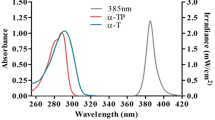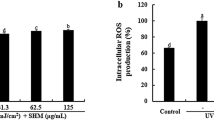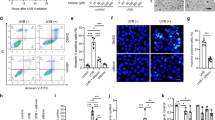Abstract
It has become clear that ultraviolet A (UVA) radiation from the solar spectrum is a major environmental challenge to the skin. This necessitates developing novel mechanism-based agents capable of ameliorating UVA-induced effects in the skin. We recently described a novel antioxidant, 3-O-Caffeoyl-1-methylquinic acid (MCGA3) from leaves of bamboo. Here, we investigated the photochemopreventive effects of MCGA3 against UVA-mediated apoptosis in immortalized HaCaT keratinocytes. Pretreatment of MCGA3 rendered cells more sensitive to subsequent UVA irradiation-induced apoptosis as well as completely reversed UVA-induced sustained phosphorylation of extracellular signal-regulated kinase 1/2 and protein kinase Cα, downregulation of p21, and reactive oxygen species generation. Interestingly, MCGA3 itself effectively induced p21 protein and mRNA levels. Silencing of p21 by RNA interference revealed a pivotal role of p21 in generating G1-S arrest and in enhancing UVA-mediated apoptosis. Transcriptional activation of p21 by MCGA3 was mediated through the proximal region of multiple Sp1 sites regardless of p53-binding site in p21 promoter, and this effect was augmented by desferroioxamine, an iron chelating agent. Additional studies suggested that iron chelation-driven hypoxia by MCGA3 may function in activation of p21. MCGA3 could be a useful agent to prevent photocarcinogenesis via apoptotic elimination of p53 mutant and DNA-repair defective cells caused by UVA radiation.
This is a preview of subscription content, access via your institution
Access options
Subscribe to this journal
Receive 50 print issues and online access
$259.00 per year
only $5.18 per issue
Buy this article
- Purchase on Springer Link
- Instant access to full article PDF
Prices may be subject to local taxes which are calculated during checkout










Similar content being viewed by others
References
Abeysinghe RD, Greene BT, Haynes R, Willingham MC, Turner J, Planalp RP et al. (2001). P53-independent apoptosis mediated by tachpyridine, an anti-cancer iron chelator. Carcinogenesis 22: 1607–1614.
Agar NS, Halliday GM, Barnetson RS, Ananthaswamy HN, Wheeler M, Jones AM . (2004). The basal layer in human squamous tumors harbors more UVA than UVB fingerprint mutations: a role for UVA in human skin carcinogenesis. Proc Natl Acad Sci USA 101: 4954–4959.
Baby SM, Roy A, Mokashi AM, Lahiri S . (2003). Effects of hypoxia and intracellular iron chelation on HIF-1alpha and beta in the rat carotid body and glomus cells. Histochem Cell Biol 120: 343–352.
Bachelor MA, Bowden GT . (2004). UVA-mediated activation of signaling pathways involved in skin tumor promotion and progression. Semin Cancer Biol 14: 131–138.
Bianchi L, Tacchini L, Cairo G . (1999). HIF-1-mediated activation of transferrin receptor gene transcription by iron chelation. Nucleic Acids Res 27: 4223–4227.
Bossenmeyer-Pourie C, Lievre V, Grojean S, Koziel V, Pillot T, Daval JL . (2002). Sequential expression patterns of apoptosis and cell cycle-related proteins in neuronal response to severe or mild transient hypoxia. Neuroscience 114: 869–882.
Carmeliet P, Dor Y, Herbert JM, Fukumura D, Brusselmans K, Dewerchin M et al. (1998). Role of HIF-1alpha in hypoxia-mediated apoptosis, cell proliferation and tumour angiogenesis. Nature 394: 485–490.
Catalano A, Rodilossi S, Caprari P, Coppola V, Procopio A . (2005). 5-Lipoxygenase regulates senescence-like growth arrest by promoting ROS-dependent p53 activation. EMBO J 24: 170–179.
Chung JH, Han JH, Hwang EJ, Seo JY, Cho KH, Kim KH et al. (2003). Dual mechanisms of green tea extract (EGCG)-induced cell survival in human epidermal keratinocytes. FASEB J 17: 1913–1925.
de Gruijl FR . (2002). Photocarcinogenesis: UVA vs UVB radiation. Skin Pharmacol Appl Skin Physiol 15: 316–320.
Fan L, Iyer J, Zhu S, Frick KK, Wada RK, Eskenazi AE et al. (2001). Inhibition of N-myc expression and induction of apoptosis by iron chelation in human neuroblastoma cells. Cancer Res 61: 1073–1079.
Fukuchi K, Tomoyasu S, Watanabe H, Kaetsu S, Tsuruoka N, Gomi K . (1995). Iron deprivation results in an increase in p53 expression. Biol Chem Hoppe Seyler 376: 627–630.
Gartel AL, Radhakrishnan SK . (2005). Lost in transcription: p21 repression, mechanisms, and consequences. Cancer Res 15: 3980–3985.
Gartel AL, Ye X, Goufman E, Shianov P, Hay N, Najmabadi F . (2001). Myc represses the p21(WAF1/CIP1) promoter and interacts with Sp1/Sp3. Proc Natl Acad Sci USA 98: 4510–4515.
Goda N, Ryan HE, Khadivi B, McNulty W, Rickert RC, Johnson RS . (2003). Hypoxia-inducible factor 1alpha is essential for cell cycle arrest during hypoxia. Mol Cell Biol 23: 359–369.
Greijer AE, van der Wall E . (2004). The role of hypoxia inducible factor 1(HIF-1) in hypoxia induced apoptosis. J Clin Pathol 57: 1009–1014.
Hammond EM, Giaccia AJ . (2005). The role of p53 in hypoxia-induced apoptosis. Biochem Biophys Res Commun 331: 718–725.
He YY, Huang JL, Chignell CF . (2004). Delayed and sustained activation of extracellular signal-regulated kinase in human keratinocytes by UVA: implications in carcinogenesis. J Biol Chem 279: 53867–53874.
He YY, Pi J, Huang JL, Diwan BA, Waalkes MP, Chignell CF . (2006). Chronic UVA irradiation of human HaCaT keratinocytes induces malignant transformation associated with acquired apoptotic resistance. Oncogene 25: 3680–3688.
Jiao Y, John Wilkinson IV, Christine Pietsch E, Buss JL, Wang W, Planalp R et al. (2006). Iron chelation in the biological activity of curcumin. Free Radic Biol Med 40: 1152–1160.
Kallassy M, Martel N, Damour O, Yamasaki H, Nakazawa H . (1998). Growth arrest of immortalized human keratinocytes and suppression of telomerase activity by p21WAF1 gene expression. Mol Carcinog 21: 26–36.
Koshiji M, Kageyama Y, Pete EA, Horikawa I, Barrett JC, Huang LE . (2004). HIF-1alpha induces cell cycle arrest by functionally counteracting Myc. EMBO J 23: 1949–1956.
Koutsodontis G, Moustakas A, Kardassis D . (2002). The role of Sp1 family members, the proximal GC-rich motifs, and the upstream enhancer region in the regulation of the human cell cycle inhibitor p21WAF-1/Cip1 gene promoter. Biochemistry 41: 12771–12784.
Kweon MH, Hwang HJ, Sung HC . (2001). Identification and antioxidant activity of novel chlorogenic acid derivatives from bamboo (Phyllostachys edulis). J Agric Food Chem 49: 4646–4655.
Kweon MH, Jung MJ, Sung HC . (2004). Cytoprotective effects of heme oxygenase-1 induction by 3-O-caffeoyl-1-methylquinic acid. Free Radic Biol Med 36: 40–52.
Kweon MH, Park YI, Sung HC, Mukhtar H . (2006). The novel antioxidant 3-O-caffeoyl-1-methylquinic acid induces Nrf2-dependent phase II detoxifying genes and alters intracellular glutathione redox. Free Radic Biol Med 40: 1349–1361.
Martin BD, Schoenhard JA, Sugden KD . (1998). Hypervalent chromium mimics reactive oxygen species as measured by the oxidant-sensitive dyes 2′,7′-dichlorofluorescin and dihydrorhodamine. Chem Res Toxicol 11: 1402–1410.
Mukherjee S, Conrad SE . (2005). c-Myc suppresses p21WAF1/CIP1 expression during estrogen signaling and antiestrogen resistance in human breast cancer cells. J Biol Chem 280: 17617–17625.
Patel V, Lahusen T, Sy T, Sausville EA, Gutkind JS, Senderowicz AM . (2002). Perifosine, a novel alkylphospholipid, induces p21(WAF1) expression in squamous carcinoma cells through a p53-independent pathway, leading to loss in cyclin-dependent kinase activity and cell cycle arrest. Cancer Res 62: 1401–1409.
Reagan-Shaw S, Breur J, Ahmad N . (2006). Enhancement of UVB radiation-mediated apoptosis by sanguinarine in HaCaT human immortalized keratinocytes. Mol Cancer Ther 5: 418–429.
Song HJ, Lee TS, Jeong JH, Min YS, Shin CY, Sohn UD . (2005). Hydrogen peroxide-induced extracellular signal-regulated kinase activation in cultured feline ileal smooth muscle cells. J Pharmacol Exp Ther 312: 391–398.
Valencia A, Kochevar IE . (2006). Ultraviolet A induces apoptosis via reactive oxygen species in a model for Smith–Lemli–Opitz syndrome. Free Radic Biol Med 40: 641–650.
Wang S, Leonard SS, Ye J, Ding M, Shi X . (2000). The role of hydroxyl radical as a messenger in Cr(VI)-induced p53 activation. Am J Physiol Cell Physiol 279: 868–875.
Wanner R, Henseleit-Walter U, Wittig B, Kolde G . (2002). Proliferation-dependent induction of apoptosis by the retinoid CD437 in p53-mutated keratinocytes. J Mol Med 80: 61–67.
Acknowledgements
This research used the facilities and support provided by US PHS Grants ROI CA 78809, ROI CA 101039 and p50 DK 065303. We thank Dr Kimitris Kardassis (University of Crete Medical School, Herakleion, Greece) for p21 promoter constructs.
Author information
Authors and Affiliations
Corresponding author
Rights and permissions
About this article
Cite this article
Kweon, MH., Afaq, F., Bhat, K. et al. A novel antioxidant 3-O-Caffeoyl-1-methylquinic acid enhances ultraviolet A-mediated apoptosis in immortalized HaCaT keratinocytes via Sp1-dependent transcriptional activation of p21WAF1/Cip1. Oncogene 26, 3559–3571 (2007). https://doi.org/10.1038/sj.onc.1210135
Received:
Revised:
Accepted:
Published:
Issue Date:
DOI: https://doi.org/10.1038/sj.onc.1210135
Keywords
This article is cited by
-
Iron Deficiency Increases Phosphorylation of SP1 to Upregulate SPNS2 Expression in Hepatocellular Carcinoma
Biological Trace Element Research (2023)
-
What is known about the medicinal potential of bamboo?
Advances in Traditional Medicine (2022)



